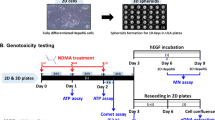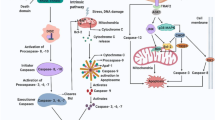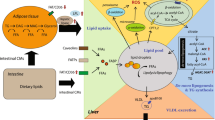Summary
Mitochondria were isolated from the livers of rats 20–24 hours after the administration of an acutely toxic dose of DMNA. The particles showed a much increased tendency to swell in the assay systems described in the preceding papers, and closely resembled previously aged normal liver mitochondria. The conclusion was drawn that the DMNA-liver particles were much less stable than their normal counterparts. The latter conclusion was corroborated by the finding of a certain measure of functional lability of the particles: increased ATP-splitting, decreased P:O ratios and some deficiency in DPN-linked oxidations. Other manifestations of the toxic effect of DMNA on rat liver, revealed by biochemical and electron microscopic examinations, are briefly discussed and compared with those observed after repeated administration of low doses of DMNA during prolonged periods. Pertinent to the present study was the finding that the fine structure of the major part of liver mitochondria following the toxic dose of DMNA was not altered, whereas after prolonged administration of DMNA in low amounts some loss of internal structure (both cristae and matrix) was observed. In sharp contrast to this observation stood the finding that the in vitro pattern of swelling of the latter particles was completely normal. The double paradox (normal structure/abnormal swelling; ‘abnormal’ structure/normal swelling) was partly resolved by the results of experiments which pointed to the possibility that the non-structurally-bound fats, accumulated in livers of rats following the toxic dose of DMNA, might become adsorbed onto the mitochondria during their isolation, and afflict damage.
Zusammenfassung
Mitochondrien aus Rattenlebern wurden 20–24 Std nach der Verabreichung einer akut-giftigen Menge DMNA (Dimethylnitrosamin) isoliert. Die Partikel wiesen eine sehr gesteigerte Neigung zur Schwellung und eine große Ähnlichkeit mit dem Verhalten von künstlich gealterten Mitochondrien auf. Die DMNA-Leberzellenmitochondrien sind also viel weniger stabil als normale. Dem entspricht auch eine gewisse funktionelle Labilität hinsichtlich gesteigerter ATP-Spaltung, verringerter P:O-ratio und Mangel an DPN-gekuppelten Oxydationen. Andere Äußerungen des toxischen Effektes des DMNA auf die Rattenleber, wie sie durch biochemische und elektronenmikroskopische Untersuchungen festzustellen sind, werden kurz besprochen und verglichen mit solchen nach wiederholter Fütterung kleinerer Mengen von DMNA während längerer Zeit. Während die Feinstruktur der Hauptmasse der Lebermitochondrien nach toxischen Dosen von DMNA unverändert blieb, war nun ein Verlust von Innenstruktur (sowohl Cristae wie Matrix) zu beobachten. In ausgesprochenem Gegensatz dazu war das Schwellungsverhalten aber vollkommen normal. Das doppelte Paradox (Normalstruktur/abnormale Schwellung; „abnormale” Struktur/normale Schwellung) wird zum Teil aufgehoben durch Experimente, welche auf die Möglichkeit hinweisen, daß die bei toxischen Dosen DMNA vermehrten nicht-strukturell gebundenen Fette in der Leber an Mitochondrien adsorbiert werden während ihre Isolierung, und diese schädigen könnten.
Similar content being viewed by others
References
Avi-Dor, Y.: A spectrophotometric study of the spontaneous and microsome-induced swelling of rat liver mitochondria. Biochim. biophys. Acta 39, 53 (1960).
Bailie, M. J., and G. S. Christie: The acute toxic action of dimethylnitrosamine on liver cells. Biochem J. 72, 473 (1959).
Baltscheffsky, H.: Mitochondrial oxidative phosphorylation in a magnesium-free medium. Biochim. biophys. Acta 25, 382 (1957).
Benedetti, E. L., and P. Emmelot: In preparation (1960).
Bernhard, W.: Die Anwendung des Elektronenmikroskopes zum Studium cellular-pathologischer Vorgänge. Klin. Wschr. 35, 251 (1957).
Bernhard, W.: Electron microscopy of tumor cells and tumor viruses. Cancer Res. 18, 491 (1958).
Brouwers, J. A. J., and P. Emmelot: Microsomal N-demethylation and the effect of the hepatic carcinogen dimethylnitrosamine on amino acid incorporation into the proteins of rat livers and hepatomas. Exp. Cell. Res. 19, 467 (1960).
Cameron, G. R.: New pathways in cellular Pathology. London: E. Arnold Ltd. 1956.
Emmelot, P.: The in vitro incorporation of C14-leucine into the proteins of tumor microsomes and a note on the properties of isolated tumor mitochondria. Exp. Cell Res. 13, 601 (1957).
Emmelot, P.: Effects of hepatic carcinogens on isolated liver mitochondria. Acta Un. int. Cancr. 14, 50 (1958).
Emmelot, P., and E. L. Benedetti: Changes in the fine structure of rat liver cells brought about by dimethylnitrosamine. J. biophys. biochem. Cytol. 7, 393 (1960). Compare: Progress Biophys. Biophys. Res. (Faraday Soc. Discussions, in press).
Emmelot, P., C. J. Bos, P. J. Brombacher and J. F. Hampe: Studies on isolated tumor mitochondria: Biochemical properties of mitochondria from hepatomas with special reference to a transplanted rat hepatoma. of the solid type. Brit. J. Cancer 13, 348 (1959).
Emmelot, P., C. J. Bos and I. H. M. Reyers: Preceding paper I (1960).
Emmelot, P., and I. H. M. Reyers: Preceding paper II (1960).
Grant, H. C., and K. R. Rees: The precancerous liver: correlations of histological and biochemical changes in rats during prolonged administration of thioacetamide and butter yellow. Proc. roy. Soc. B 148, 117 (1958).
Magee, P. N.: Toxic liver injury. Inhibition of uptake of labeled amino acids into liver protein in vivo by dimethylnitrosamine. Biochem. J. 65, 31 P (1957); 70, 606 (1958).
Magee, P. N., and T. Hultin: Abstr. 4th Intern. Congr. Biochemistry, Vienna, 1958, p. 185 (14–50, 49).
Man, J. C. H. de: Observations, with the aid of the electron microscope, on the mitochondrial structure of experimental liver tumors in the rat. J. nat. Cancer Inst. 24, 795 (1960).
Porter, K. R., and C. Bruni: An electron microscope study of the early effects of 3'-Me-DAB on rat liver cells. Cancer Res. 19, 997 (1959).
Pressman, B. C., and H. Lardy: Effect of surface active agents on the latent ATPase of mitochondria. Biochim. biophys. Acta 21, 458 (1956).
Rouiller, Ch., and W. Bernhard: “Microbodies” and the problem of mitochondrial regeneration in liver cells. J. biophys. biochem. Cytol. 2 (Suppl.), 355 (1956).
Author information
Authors and Affiliations
Rights and permissions
About this article
Cite this article
Emmelot, P., Bos, C.J. & Reyers, I.H.M. The swelling of normal, preneoplastic and neoplastic liver mitochondria. Z Krebs-forsch 64, 52–63 (1960). https://doi.org/10.1007/BF00524276
Received:
Issue Date:
DOI: https://doi.org/10.1007/BF00524276




